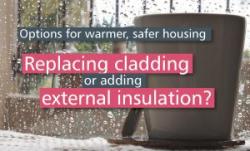SAS Replacement cladding for fire safety and reduced heating costs
 Replacement cladding for fire safety and reduced heating costs
Replacement cladding for fire safety and reduced heating costs
There are many reasons to consider replacement cladding for a building or add external insulation, and many benefits in doing so. The original render may have failed with cracks letting in cold and damp, older solid wall buildings may need updating, or new fire regulations may have made the existing cladding an unacceptable fire risk.
Privately owned homes have these problems, but there are also over 4 million homes provided by social housing in England alone, for which local authorities and housing associations have responsibility for.
The biggest costs to social landlords are ensuring that homes have efficient heating and insulation, and that the building is safe in respect of fire, especially following the Grenfell fire and new regulations for buildings with cladding over 18 metres high.
Replacement cladding options
Following the Grenfell fire, councils, housing associations and private sector leaseholders can apply to the government to fully fund removal and replacement of unsafe cladding on social residential buildings 18 metres or over.
New cladding regulations require non-combustible materials to be used for residential building over 18 metres, and the system used must be A rated for fire. Take a look at the ProWall rendered rainscreen cladding system, classified as A2-s1,d0 ‘reaction to fire’. This is fully compliant with the new regulations, and has demonstrable barrier fire seals within the cladding that have been fire tested to 99 minutes integrity. Additionally, it has been awarded a 60-year certificate of durability from the BBA (an independent regulation body). If you are replacing unsafe aluminium cladding, ProWall also provides a reassuringly different look to the building – an attractive rendered finish available in a wide-range of colours. Residents and local people can easily see that the cladding has been replaced by a different, safe material.
Rendered replacement cladding is also a great choice to update failed render on older buildings or privately-owned homes, as the cladding can accommodate a range of different substrates and uneven surfaces. Existing render may have failed due to the wrong products having been used or poorly applied, leading to water ingress and cracking. The existing render may also consist of a now obsolete system that uses metal meshing with a sand and cement mix which has failed due to weather exposure. ProWall was used to rectify this failed render system on flats in Cornwall and to save this timber framed house with cracking and damp problems.
The low maintenance ProWall has a modern silicone render finish that is waterproof, flexible and breathable, with the whole system having been certified for 60 years of durability. Housing with this rendered rainscreen cladding are free from damp, as the ventilated cavity ensures breathable walls, condensation drainage and air circulation. Contact us for more information about the ProWall system, whether you have one house to update or are looking for cladding solutions for a social housing portfolio.
External insulation options
For some properties, external rendered insulation is the best option when replacing cladding or solving damp issues and reducing heating costs. If the building has solid walls, is poorly insulated, costs too much to heat or suffers from damp, external insulation can solve the problem. The Energy Saving Trust reports that external insulation can reduce annual heating bills by an average of £260 for a gas-heated semi-detached home.
The ProRend External Insulation Finishing System (ProRend EIFS) has the same durable, weatherproof rendered finish of ProWall (above), with an attractive rendered finish. Unlike internal insulation, it can be applied without disruption and does not reduce the floor area of the house. It renews the appearance of outer walls, filling draughty cracks in brickwork, adds soundproofing, and protects the walls from further exposure damage. The insulation system will reduce condensation on internal walls and prevent water ingress from the outside.
ProRend EIFS can be applied to timberframe or steel frame buildings, and there are several options for the insulating material, including A-rated options for use over 18 metres. It has high thermal efficiency and a long-lasting rendered finish. Contact us for more information about the ProRend EIFS system, whether you have one house to update or are looking for insulation solutions for a social housing portfolio.
Both the ProWall rendered rainscreen and the ProRend EIFS external insulation system are from UK company SAS Europe Ltd. The systems can also be used together on the same building seamlessly as they have the same, durable rendered finish. See a case study of a new apartment building here where external insulation and ventilated cladding are used together.
SAS Europe have a technical team that work with your consultants and applicators for the duration of the project to advise on the right replacement cladding options for you to get the results you want.